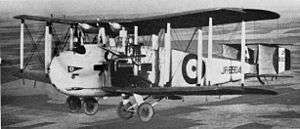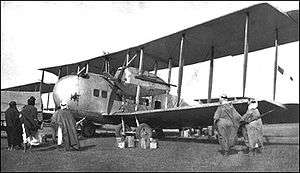Vickers Vernon
| Vernon | |
|---|---|
 | |
| Vernon of 70 Squadron RAF, powered by Rolls-Royce Eagle engines. | |
| Role | Transport |
| Manufacturer | Vickers |
| Introduction | 1921 |
| Retired | 1927 |
| Primary user | Royal Air Force |
| Number built | 55 |
| Developed from | Vickers Vimy Commercial |

The Vickers Vernon was a British biplane troop carrier[1] used by the Royal Air Force. It was the first dedicated troop transport of the RAF, entering service in 1921.
The Vernon was a development of the Vickers Vimy Commercial, a passenger variant of the famous Vickers Vimy bomber, and was powered by twin Napier Lion engines or Rolls-Royce Eagle VIII engines.[1] 55 were built.
In February 1923, Vernons of Nos. 45 and 70 Squadrons RAF airlifted nearly 500 troops to Kirkuk, Iraq[2] after the civilian area of that town had been overrun by Kurdish forces. This was the first-ever[3] strategic airlift of troops.
Vernons of No. 45 Squadron had bomb racks and sights fitted.[4] In May 1924 the squadron was officially designated No. 45 (Bombing) Sqdn.[5]
Vernons were replaced by Vickers Victorias from 1927.
Variants
- Vernon Mk I
- Twin-engined military transport aircraft for the RAF.
- Vernon Mk II
- Powered by two 450 hp (340 kW) Napier Lion II piston engines.
- Vernon Mk III
- Powered by two Napier Lion III piston engines.
Operators
Specifications (Vernon)
Data from Aircraft of the Royal Air Force[6]
General characteristics
- Crew: three
- Capacity: 11 passengers
- Length: 42 ft 8 in (13.01 m)
- Wingspan: 68 ft 1 in (20.76 m)
- Height: 13 ft 3 in (4.04 m)
- Wing area: 1,330 ft² (124 m²)
- Empty weight: 7,981 lb (3,628 kg)
- Loaded weight: 12,554 lb (5,706 kg)
- Powerplant: 2 × Napier Lion, 450 hp (336 kW) each
Performance
- Maximum speed: 87 kn (100 mph, 161 km/h)
- Cruise speed: 65 knots (75 mph, 121 km/h)
- Range: 278 nmi (320 mi,[7] 515 km)
- Service ceiling: 11,700 ft[7] (3,600 m)
- Wing loading: 9.44 lb/ft² (46.0 kg/m²)
- Power/mass: 0.0717 hp/lb (0.118 kW/kg)
See also
- Related development
- Related lists
References
| Wikimedia Commons has media related to Vickers Vernon. |
- 1 2 "Aircraft of the Royal Air Force Since 1918" Owen Thetford, Putnam & Co. Ltd. London 1962, p.443
- ↑ Wragg, David Airlift A History of Military Air Transport Shrewsbury Airlife Publishing 1986 ISBN 0-906393-61-2 p13
- ↑ Johnson, Brian & Cozens, H. I. Bombers The Weapon of Total War London Methuen 1984 ISBN 0-423-00630-4 p.38
- ↑ Mission Completed, Air Chief Marshal Sir Basil Embry, White Lion Publishers Limited, London 1976, ISBN 0-7274-0260-9, p.34
- ↑ "Bomber Squadrons of the R.A.F. and Their Aircraft" Philip Moyes, MacDonald & Co. (Publishers) Ltd, London 1964, p.67
- ↑ Thetford, Owen (1957). Aircraft of the Royal Air Force 1918-57 (1st ed.). London: Putnam.
- 1 2 Andrews, E.N.; Morgan, E.B. (1988). Vickers Aircraft Since 1908 (Second ed.). London: Putnam. pp. 76–104. ISBN 0-85177-815-1.